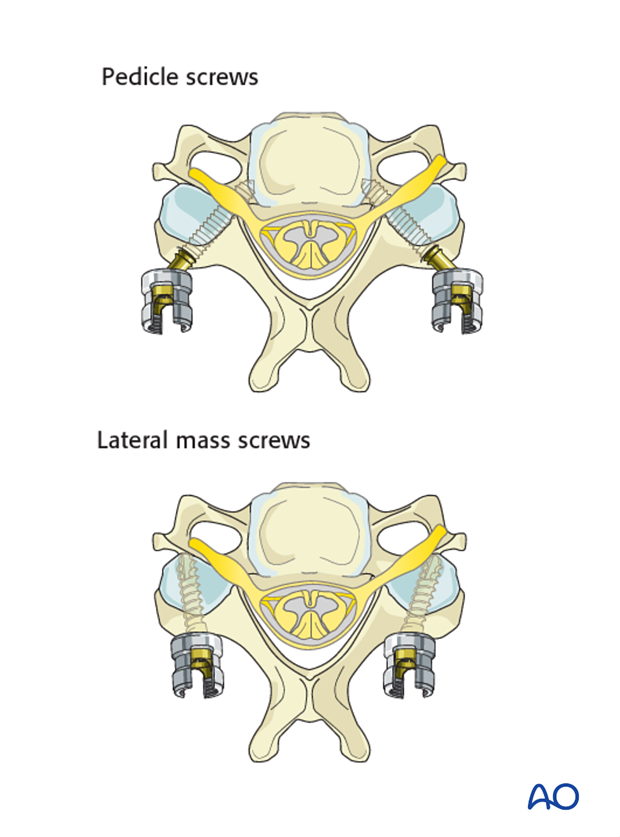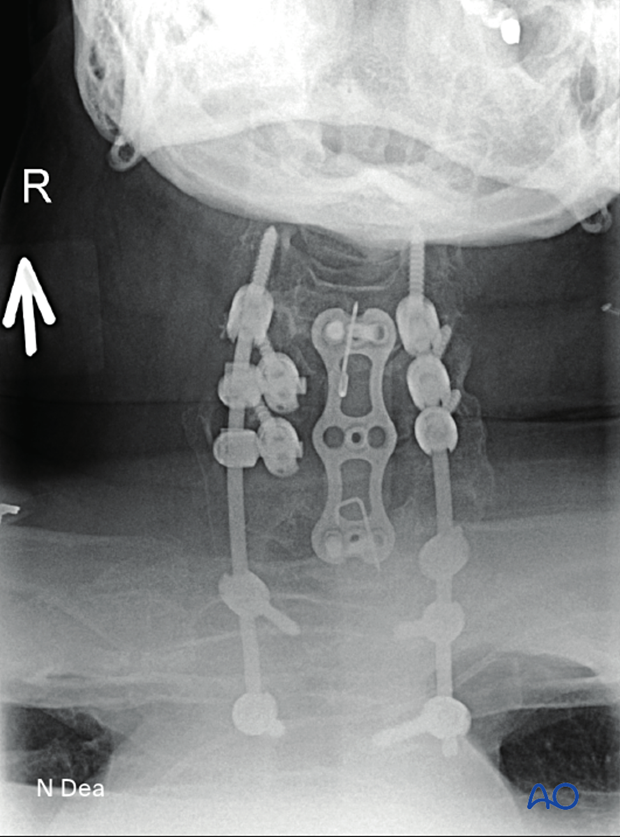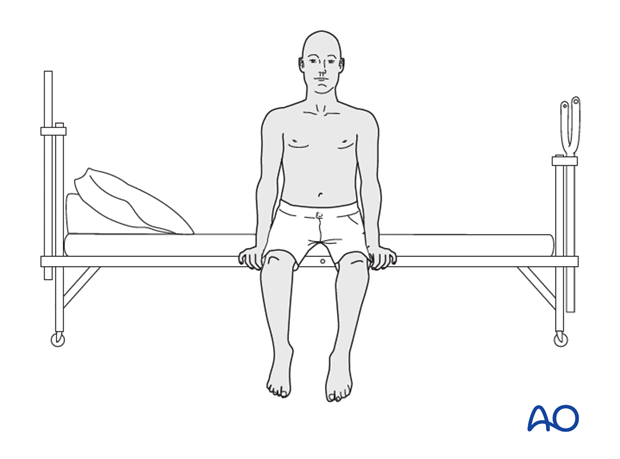Intralesional resection (C3 to C7)
1. Introduction
Preoperative management
Proper planning is instrumental in the management of primary spine tumors. A multidisciplinary approach may be required depending on the localization of the tumor.
Embolization
Embolization procedures are recommended to reduce operative blood loss in hypervascular tumors, especially during more extensive resections.
Embolization should be considered for hypervascular tumors, such as giant cell tumors, aneurysmal bone cysts, and hemangiomas.
The role of the embolization is:
- To reduce the vascularity of the tumor
- To facilitate dissection around the tumor
Embolization on its own may also have a therapeutic effect.
This image shows the embolization of a hypervascular tumor.

Resection strategy
A posterior approach is by far the most common procedure for these tumors.
For the rare instances when an anterior approach is chosen for an intralesional resection, please refer to the anterior resection of metastatic tumors in the dedicated section of the AO Surgery Reference.
The relationship between the tumor and the vertebral artery is important and should be assessed on preoperative MRI and CT scans.
A wide visualization is essential in these cases, and a laminectomy involving half a level above and below the tumor is recommended.
The goal is to achieve:
- Good visualization of normal and abnormal anatomy
- Safe decompression of the neural elements

Reconstruction strategy
Posterior reconstructionTypically, two levels above and below the affected vertebra are included.
As the procedure is often curative, it is important to verify that the spine is reconstructed in good alignment, and a solid bony union should be attempted.
If a posterior element tumor only involves segments 1 and/or 12, resection can be performed without the need for an instrumented fusion.

Case-based scenario
Most benign primary tumors will be localized in the posterior element with variable extension into the vertebral body.
Every case is unique.
To illustrate the surgical principle of a posterior intralesional resection, we will use a C5 tumor located in segments 1–4 of the WBB classification.

2. Patient preparation and surgical approach
Patient preparation
The patient is placed prone.

Surgical approach
A posterior midline approach to the cervical spine is performed.
A wider dissection will typically be performed for primary tumors compared to a trauma case.
Following a midline incision, the subcutaneous tissues are dissected down to the chosen dorsal plane of dissection.
The dissection is carried laterally around the tumor until the normal bone is reached.

The incision may need a cranial extension when the tumor involves the upper cervical spine.

The incision may need a caudal extension when the tumor involves the lower cervical spine.

3. Screw insertion
Insert all screws according to the preoperative plan.

If C1 instrumentation is indicated, lateral mass screws are used.

For C2 fixation, the following options are available (in order of preference):
Consideration is given to using pedicle or laminar screws when doing an occiput to C2 fusion, as the starting point for pars screws often compromises the facet joint.

Fixation can be achieved with either lateral mass screws, pedicle screws, or a combination of the two.
Because lateral mass fixation is generally sufficient and carries less risk, pedicle screw fixation is limited to rare cases where lateral mass fixation would be insufficient or is not possible. A pedicle screw is most often used in C7 if instrumented.

Occipital instrumentation
Extending instrumentation to the occiput may be necessary when the tumor involves the higher cervical spine.

Thoracic instrumentation
Extending instrumentation to the thoracic spine may be necessary when the tumor involves the lower cervical spine.

4. Decompression
Laminectomy
Perform a laminectomy according to the preoperative plan.

Dissection should progress from normal to abnormal tissues to protect normal neurological elements and facilitate dissection.

5. Tumor resection
Use reverse-angle curettes and pituitary rongeurs to debulk the tumor.
Spinal cord mobilization should be minimized to reduce the risk of neurological injury.
The goal is to achieve gross total resection.
Intraoperative navigation can be used as an adjunct to maximize resection accuracy.

Once the tumor is entirely resected, the goal of the surgery is met.

Reconstruction
Rod contouring and insertionEvery effort should be made to contour the rod to decrease the risk of induced sagittal or coronal malalignment.
Contour the rod to align it with the lordosis achieved during positioning.

Insert the rods into the screw heads and secure them by tightening the inner nuts.
For non-fusion surgeries, consideration should be given to using large-diameter rods (4.0 mm) to prevent rod fracture.

Fusion
Excise the facet capsule and denude/curette the joint cartilage surfaces and posterior cortex.

Grafting
Insert pieces of bone graft (autograft, allograft) into the decorticated facet joint for fusion.

6. Intraoperative imaging
Before wound closure, intraoperative imaging is performed to check the adequacy of reduction, position, and length of screws and the overall coronal and sagittal spinal alignment.

Lateral view of the above case

7. Posterior closure
Perform a multilayer closure as described in the approach.
For patients undergoing tumor surgery and/or with a history of radiation:
- Plastic surgery should perform soft-tissue reconstruction to decrease the risk of wound complications
- Intrawound vancomycin can be applied to decrease the risk of postoperative wound complications

8. Aftercare
Patients are made to sit up in bed on the first day after surgery. Patients with intact neurological status are made to stand and walk on the first day after surgery.
Patients can be discharged when medically stable or sent to a rehabilitation center if further care is necessary.
Throughout the hospital stay, adequate caloric intake of a high-quality diet should be monitored.

Patients are generally followed with periodical x-rays at 6 weeks, 3 months, 6 months, and 1 year to monitor for hardware failure and with an MRI every 6 months for tumor surveillance.
Some primary benign tumors of the spine can recur years after surgery, and long-term tumor surveillance is important.













